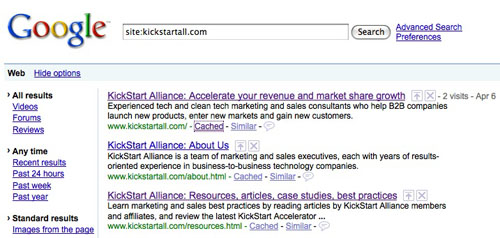I had the pleasure of hosting the Northern California BMA eMarketing Roundtable last week in Palo Alto. Dave Lloyd, Search Marketing Manager at Cisco, discussed best practices in optimizing blended (or universal) search. Here are a few key takeaways from Dave’s talk:
- Search Engine Optimization (SEO), otherwise known as “organic” or “natural search”, is the process of creating content rich with keywords and cross links so that your website URL or links to your digital assets appear at the top (preferably above the fold on the first page) of search engine results. Search engines have automated “spiders” that crawl the web, extract information and build an index. The goal is to have those spiders find, index and store your content. You can find out if your site is being “spidered” by typing into Google “site:root domain.” For KickStart’s site I typed in “site:kickstartall.com” and viewed the result below. I clicked on “cached” in the first listing and it told me that the page was last cached on June 10th, 2009 – less than one week ago.

kickstartall.com
- Blended (or universal) search is the term for search results that come not only from text content, but from news items, images, videos, maps, blogs, groups, etc. According to comScore in Sept. 2008, 30% of search results reference blended content. Text-only content is getting pushed down in rankings.
- To optimize SEO, focus on your business goals/content, the search engine and on the searcher. Use keywords that your target audience will likely type into their search queries. Place keywords in sub-domain URLs, the HTML title tag and in the anchor text (or label on links). For example, replace “Learn More” with keywords like “Sales Process Tips.” Google AdWords Keyword Tool will help you identify popular search words and phrases.
- To boost blended search results, use relevant keywords in blog post titles and in the title and description of images and videos. You can also embed an HTML element in FLASH assets.
According to a TechWeb survey, 87% of corporate executives and 78% of IT executives rely on search engines when conducting research. Given these statistics, it is worth the investment of time and resources to create search-friendly digital assets to improve the chance that your content appears above the fold on the first page of results.
